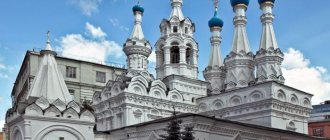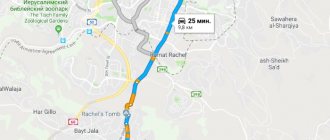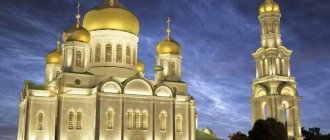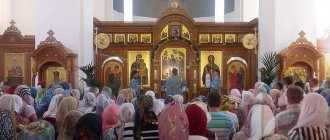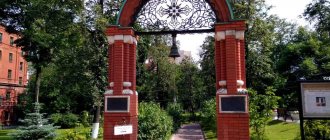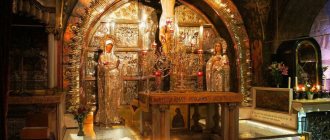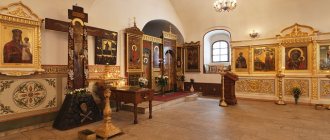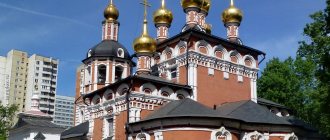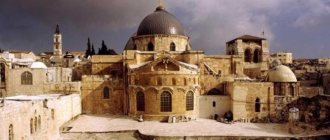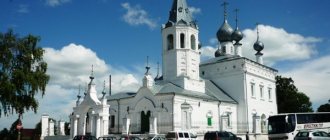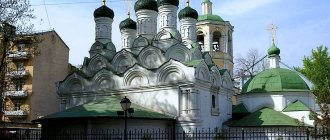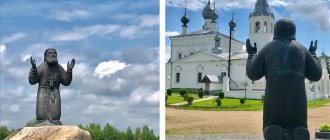The current Cathedral of the Nativity of the Blessed Virgin Mary in Ufa inherits the cathedral status of its predecessor, the Resurrection Cathedral, which has now been revived and also retains cathedral significance.
In 1901, a solemn ceremony of laying the foundation of the new Cathedral of the Nativity of the Virgin Mary , after which the main construction work began. The future cathedral was to be located on the eastern side of Priyutskaya Street (today S. M. Kirov Street).
Priyutskaya Street, like a river into the sea, “flowed” into the city square, a large square of which would surround the Church of the Nativity of the Virgin Mary, becoming its cathedral territory. And Priyutskaya Square was destined to very soon receive a name in honor of the new cathedral - Rozhdestvenskaya.
The construction of the main city cathedral lasted until 1909. The Nativity Cathedral turned out to be elegant: the greenery of the roof harmonized beautifully with the bronze-covered crosses of its massive domes.
The brick building of the main volume was decorated with a three-tier bell tower, and the dome, although made of wood, was skillfully covered with iron and also painted “to resemble brick.” On August 23, the whole world raised bells to the bell tower of the newly built cathedral. Of the eight new ringers, the ten-pounder was the smallest. But the most massive one pulled 50 pounds and 35 pounds.
There was enough space in the church: the total length of its building including the bell tower was 206.5 fathoms with a maximum width of 10.5 fathoms. Considering that one fathom was 2.13 meters, it was quite a spacious temple for its time.
On September 6, 1909, the new Ufa Cathedral was consecrated - the northern aisle in the name of St. Nicholas the Wonderworker; southern - in the name of the Archangel Michael.
The Cathedral of the Nativity of the Virgin Mary was the last Orthodox church in Ufa built in the pre-revolutionary period.
The temple was going to be built throughout the 19th century, but was built only at the beginning of the 20th century
In the 19th century Ufa grew, the population became more and more. At the end of the 19th century. 50 thousand people already lived in Ufa. Existing churches could not accommodate everyone who wanted to attend the service.
At the end of the 19th century. They built several churches, but the city needed a large cathedral that could accommodate many believers.
The place for the new cathedral was found by the Ufa bishop Anthony Khrapovitsky.
Bishop Anthony of Ufa became the founder of the Church of the Nativity of the Virgin Mary
Anthony chose the location for the new temple well: the temple was to be located on the same straight line with the Sergius and Intercession churches. They planned to make a square around the church, which was later given the name Priyutskaya (Rozhdestvenskaya).
Priyutskaya Street stretched to the west from the future temple, which symmetrically ended with the Alexander Church on Alexander Square.
On the plans of Ufa, a place for the temple was allocated at the end of the 19th century
There was no money for construction. The project stood idle until 1901, until the merchant and member of the City Duma Nikifor Mironovich Patokin donated money for the temple.
The temple began to be built in the “brick” style. There was experience: earlier, the St. Nicholas Station Church was built in the same style.
The “brick” style in architecture referred to the traditions of pre-Petrine Rus'
The original appearance of the cathedral in the “brick” style has not been preserved. Now the eyes of believers are pleased with the later reconstruction
Inside the Cathedral of the Nativity of the Blessed Virgin Mary
The Church of the Nativity of the Blessed Virgin Mary in Ufa is one of its largest and most spacious churches: it was originally built for the future as a future cathedral. With strong walls that are more than a meter thick in places, it was further expanded during restoration in the 1990s and can now accommodate more than three thousand people during services. Colorful artistic paintings on the walls, vaults and ceilings of the building largely determine its leading role among the Orthodox attractions of present-day Ufa.
The iconostasis was installed in December 2004, and the following year two more appeared in the chapels. At the same time, the paintings of the temple were mostly completed. The main iconostasis was created specifically taking into account the size of its main icons of the 19th century - the Savior and the Blessed Virgin Mary.
At one time, they appeared in the cathedral thanks to the famous preacher John of Kronstadt, who, at the request of the Ufa clergy, ordered them from one of the Athos monasteries, and paid for them with his own money.
The decoration of the interior of the Church of the Nativity of the Virgin Mary invariably arouses the admiration of its visitors. In the process of restoring the walls and floor, marble was used - yellow Pakistani and white Greek. The floors were laid using pink Italian stone; for decoration, Italian wall mosaics were used, the material for which was South African granite in gray-blue tones and serpentinite (serpentine) of a characteristic green color with various inclusions.
Lavish wall paintings were applied to the walls, vaults and ceilings by hand. The subjects of the frescoes in the central area of the cathedral partly repeat the picturesque compositions of the capital's Cathedral of Christ the Savior, since in both Moscow and Ufa both of these churches are painted in the academic church style, characteristic of Russia at the end of the 19th century.
Worship in the temple began in 1909
The construction of the temple took 8 long years. In August 1909, bells were raised to the bell tower, and on September 6, Bishop of Ufa and Minzelinsk Nathanael consecrated the temple. Vasily Grigorievich Lezenkov became the rector.
The first rector of the Church of the Nativity of the Virgin, Vasily Grigorievich Lezenkov, was repressed in 1937 and became a new martyr
Two chapels were made in the cathedral: the northern one was consecrated in honor of St. Nicholas the Wonderworker, the southern one in honor of the Archangel Michael. Immediately after the consecration, services began in the temple.
Shrines
The Temple houses many Orthodox Shrines, which are constantly available for worship by believers.
Icons with parts of relics and Saints
The main shrines of the Church of the Nativity of the Virgin Mary are icons with parts of the relics of St. Nicholas the Wonderworker;
- Great Martyr Panteleimon the Healer;
- Equal to the Apostles Nina of Georgia;
- Great Martyr George the Victorious;
- Holy Great Martyr Barbara;
- St. Sergius of Radonezh;
- Venerable Seraphim of Sarov;
- Alexander Nevsky;
- Peter and Fevronia:
- Righteous Theodore Ushakov;
- Martyrs Tatiana and Tryphon.
The Cathedral Church also houses icons of the Holy Life-Giving Trinity with a piece of the Oak of Mamre and the Last Supper with a piece of the Upper Room of Zion.
Other attractions
The Temple's attractions also include wall paintings and three iconostases, which appeared in 2005 during the process of restoration work, as well as a monument to Denis Davydov, erected in 2004 on the temple grounds.
During Soviet times, the temple was converted into a cinema
During the turbulent times after the revolution and civil war, the temple managed to hold on. In 1919, a hospital was placed in it, but religious services did not stop.
After the end of the civil war, the clergy of the cathedral switched to renovationist positions. Renovationism is a movement in the Orthodox Church that supports the Bolsheviks
The Orthodox Church, although “renewed,” was not needed in the USSR, which proclaimed a course towards atheism. From the beginning of the 30s, an intensified struggle against the Orthodox faith began.
Renovationism did not save the clergy from repression.
In 1934, the wave of atheism reached Ufa. The Church of the Nativity of the Virgin Mary was closed. By resolution of the Presidium of the Bashkir Central Executive Committee, the temple was given to “Bashkino”. But the premises were empty until 1938, when aviation workshops were located in the building.
In 1950, the temple was converted into a cinema: the dome and wooden drum were removed (the end was at the bell tower, extensions and a portico were made at the entrance, the ceilings were changed. The room for communication with God became an entertainment establishment.
In the 50s, the temple building was converted into a cinema, which was called “Yondoz”
ON KIROVA STREET - PRIYUTSKAYA
Nativity of the Virgin Mary Church, the most significant building on Kirov Street. Ufa. Photo by Sergei Sinenko
From the House of Trade Unions to the Nativity of the Theotokos Church
Sergey Sinenko
Today - a walk along Kirov Street. The length of the street is 3 km. It starts from the House of Trade Unions (Kirova St., 1), built on the site of the Alexander Church, goes in a straight line to the Nativity of the Theotokos Church (distance about 2 km), goes around its territory, and then stretches downhill towards the Sutolotsky ravine, ending at road fork at the intersection with Salavat Yulaev Avenue. The original name was Priyutskaya, in honor of the Orthodox orphanage, opened in 1849 and located in the quarter between Telegrafnaya (now Tsyurupy) and Malaya Uspenskaya (Engelsa).
The street was renamed in honor of the prominent party and government figure S. M. Kirov (Kostrikov), who enjoyed great authority among the population.
Engraving by S. Yudovin. Farewell to Kirov. 1935
Let's start our walk along the street in the square in front of the House of Trade Unions. This is one of the historical squares of the city, previously called Alexandrovskaya, sometimes – Barracks. During the years of Soviet power, its purpose and architectural appearance completely changed. Along with Cathedral Square, it was designed in 1819 by the capital’s architect V. I. Geste as an ensemble of buildings in the classicist style, and then built up in accordance with the project.
This square was intended to be the architectural dominant of the north-western part of the city so that in the north-eastern part there would be its mirror image - Priyutskaya Square, on which V. I. Geste also planned a temple (the Nativity of the Theotokos Church was built here only at the beginning of the 20th century).
The Alexander Church was built with funds from the Ufa Noble Assembly and designed by the capital's architect Visconti. It was opened in 1836. Later it was surrounded by a cast-iron fence of Kasli casting
The main decoration of the square was the Alexander Church, for the construction of which a natural hill was used, which made it possible to raise the temple by several meters, making it convenient for viewing from a considerable distance. As a result, in violation of the rules of regular urban planning of the 19th century, Aleksandrovskaya Square was located asymmetrically to other city squares, and Aleksandrovskaya Street (now K. Marx), which goes around the temple from the west, was curved in a semicircle.
The first stone in the foundation of the temple was laid by Russian Emperor Alexander I, who visited Ufa in 1824 during his trip to the Orenburg province (Orenburg, Ufa, Sterlitamak, Birsk, Zlatoust and Satkin factories, Iletsk protection). There were eight bells on the bell tower of the Alexander Church.
The church was “small, the architecture was simple; the interior furnishings, especially the iconostasis, are poor, except for some, however, images in good frames and icon cases,” wrote M. Somov (1864).
Alexander Square took shape architecturally in the 1840s, when a temple and two two-story barracks buildings for the Ufa Line Battalion (1833–1840) were completed. Hence another name for the square – “Barracks”.
According to the architect S. Yu. Semenova, according to the general plan of 1819, Alexander Square was supposed to become one of the peripheral ones, but after the construction of the barracks it turned into one of the areas of administrative significance, since it was used as a place for the public execution of criminals. Note that the name “Barracks” was used in documents precisely when this purpose was indicated; a wooden scaffold, consisting of a platform with railings and a gallows, was installed in the western part of the square near the barracks.
The Alexander Church was closed in 1931. In the pre-war years, construction began on the church foundation of the Palace of Socialist Culture, known for a long time as the “burnt factory”. Currently, only the barracks buildings have survived from the old buildings, the fate of which is also in question. On the site of the temple there is the House of Trade Unions (Kirova St., 1), which houses the federation of trade unions of the republic, uniting the republican trade unions of workers in culture, public education and science, healthcare, forestry, agriculture, water and utilities, chemical, mining metallurgical, oil, gas and other sectors of the national economy.
The square in front of the House of Trade Unions, former Alexander Square. Ufa. Photo by Sergei Sinenko
As a result of construction along the perimeter of the square in 2000–2006. luxury buildings have acquired a finished look. After landscaping, a large park appeared in front of the House of Trade Unions.
If the northern side of the square is occupied by residential buildings, then on the southern side for a long time there was a complex of buildings of Bashkirenergo, a production association for energy and electrification (K. Marx St., 30). The scope of its activities is the production, transmission and distribution of electrical and thermal energy; repair and maintenance of power equipment.
It is one of the largest producers of electrical and thermal energy in Russia: it ranks second in terms of installed capacity for the production of thermal energy and sixth place in terms of installed capacity for the production of electrical energy. The power consists of the capacities of 11 thermal power stations, 10 boiler houses, 2 gas turbine units, 1 hydroelectric power station and 2 small hydroelectric power stations. These include Ufa CHPP No. 1 (1938), No. 2 (1940), No. 3 (1951), No. 4 (1956), as well as network enterprises - Ufa City Network (1933) and Central Network (Ufa, 1953). Currently, the association includes more than thirty branches.
The House of Trade Unions was erected on the foundation of the Alexander Church. Photo by Sergei Sinenko
We continue our walk. The square turns into a green boulevard. The odd-numbered side of the block is opened by a residential complex built in 2006–2007; on the even-numbered side the building of the Bashkiria Hotel stands out (more about it in a walk along Lenin Street).
Diagonally from the hotel there is the republican scientific, technological and information complex “Bashtekhinform” (Kirova St., 15). It was created in 1966 as the Center for Scientific and Technical Information (CSTI). The building took several years to construct.
On the corner of Kirov and Lenin streets in the mid-1960s. there was a kindergarten, Aeroflot ticket offices and wooden residential buildings. Kindergarten teachers and parents, having learned about the upcoming demolition, staged an unusual demonstration for that time - they lined up their children on the street in protest. This worked - the kindergarten was immediately provided with a new building. Resettlement from the private sector took a long time, but through the efforts of Nikolai Nikolaevich Tsibulin, appointed director of the CSTI, almost sixty new apartments were issued and satisfied new residents sent greeting cards to N.N. Tsibulin for several years for the holidays.
The five-story building of the CSTI is gray, completely faceless, and has not decorated the central street. The issue of decorating the facade with mosaic panels was decided at the level of the country's leadership. At that time, Chairman of the Council of Ministers of the USSR Alexey Nikolaevich Kosygin was in Ufa on a business visit. During a meeting with him at CNTI, N. N. Tsibulin was able to convince him that the panel would not be an excess for the building. The idea was approved.
Smalt (multi-colored glass) for mosaics was brought from Moscow and Kyiv, and marble and jasper from the Urals. The panel was made by a group of monumental artists under the direction of artist A.V. Panteleev, the author of the main solution.
CSTI in the 1960s – 1970s. meant a lot to the city and the republic. The center was engaged in information support for the activities of research, design and engineering organizations and enterprises, and subsequently in the development and implementation of new information technologies, as well as the creation of electronic information resources of scientific and technical information on the Internet and on CDs. Today, the Bashtekhinform building houses administrative services and some of the divisions of the Academy of Sciences of the Republic of Belarus. The first electronic ticker in the city, reporting regional news, was installed above the entrance to the building.
In a narrow block between Tsyurupy Street (formerly Telegraphnaya) and Khudaiberdin Street (formerly Tserkovnaya) there was an institution that gave the name to the street - Priyutskaya. The opening of the first orphanage in the city took place here in 1849. The proposal to organize it initially came to the provincial authorities from the chairman of the all-Russian Main Committee for the Guardianship of Orphanages, Count Stroganov. He turned to Orenburg Governor-General V.A. Obruchev with a request to assist in the creation of charitable institutions. First, a trusteeship of orphanages was established in Ufa, which collected private donations. They turned out to be sufficient to open a shelter for orphans and low-income children in two buildings, residential and working. It was after this that the street that was being formed at that moment received the name Priyutskaya.
In 1887, a new two-story building was built for the orphanage, designed for 60 children of both sexes. Considerable attention in the shelter was paid to teaching crafts; for this purpose, carpentry, bookbinding and shoemaking workshops were set up, which carried out orders of varying complexity, from the simplest to the most professional.
In the “Siberian part” of Ufa (in the area of the Old Siberian Road) there were two provincial hospitals - a zemstvo hospital and a psychiatric
This part of the street is built up with typical five- and nine-story residential buildings. On the even side are the buildings of the pharmaceutical enterprise "Ufavita" - the former Ufa Vitamin Plant. The enterprise arose during the Great Patriotic War on the basis of the Ufa confectionery factory. In November 1941, the installations of the Moscow Vitamin Plant, which had been evacuated to Ufa, were put into operation in pre-revolutionary buildings. After a special Resolution of the Council of People's Commissars of the Bashkir Autonomous Soviet Socialist Republic, the collection of medicinal raw materials began throughout the republic. The Bashsoyuz, the Bashkooppromsovet, the People's Commissariat for Food Industry and the Bashkontore "Roskhmel" were entrusted with procuring rose hips for the plant's needs; Land plots were allocated to organize a state farm for growing vitamin rose hips, and the road department under the Council of People's Commissars of the BASSR included rose hips in the mandatory planting of forest protection fields.
During the war, the vitamin plant produced a variety of drugs to treat the wounded. Medical scientists evacuated to Ufa developed effective methods for treating the wounded and new medicines. Under the leadership of Academician A.V. Palladin, the Ufa Vitamin Plant launched the production of a drug that accelerates wound healing; a group of scientists led by Academician A.A. Bogomolets produced a serum that was used in the treatment of gunshot wounds and infectious diseases. Its production was established in Bashkiria. Using a new method of obtaining vitamin C from rose hips, introduced at the Ufa Vitamin Plant, an active multivitamin preparation was produced, which was not produced anywhere except Ufa. The method of obtaining vitamin C from pine needles also turned out to be effective. Materials and documents related to the heroic pages of the enterprise’s activities are stored at the enterprise and in the State Archives.
Kirova Street in the Vitamin District runs along a dam. The ravine on the southern side is significantly smoothed out, but is still recognizable.
Let's continue our walk. The odd side of one of the next blocks is occupied by the Republican Clinical Hospital named after G. G. Kuvatov. This clinic arose in 1876 as a zemstvo hospital in the Ufa province with two resident doctors and 51 beds.
Today it is a large multidisciplinary clinical treatment and preventive institution with more than 1,200 beds, employing about 400 medical specialists of various profiles. The hospital's advisory clinic for 1,200 visits provides consultations and treatment in 48 specialties, there are 24 specialized departments and on their basis 22 republican treatment and diagnostic centers, providing consultation to 350 thousand patients and treatment of 25 thousand patients annually.
Historical and modern buildings of the Republican Clinical Hospital named after G. G. Kuvatov. Ufa. Photo by Sergei Sinenko
The hospital performs 14 thousand surgical interventions annually. To provide emergency medical care using air ambulances and cars, doctors carry out about 2 thousand flights and visits annually. The hospital operates a transplantology center, donor kidney transplants are successfully carried out, and a basis is being created for organizing liver transplants using laser surgery. New treatment methods have been introduced using laser and allograft, and other modern treatment methods. The main republican medical institution is named after G. G. Kuvatov, the first People's Commissar of Health of the republic. In 2003–2007 According to the project of the Bashpromstroyproekt Institute, the surgical building of the Republican Clinical Hospital was reconstructed.
Twelve-entrance “ship”, view from Bolshaya Moskovskaya Street on Sergievsky Hill. Ufa. Photo by Sergei Sinenko
After two blocks the street ends at the church fence of the Nativity of the Theotokos Church. On the southern side of the temple square there are houses of old wooden buildings - the Soldatskaya Sloboda area. On the northern side rises the longest residential building in Ufa, popularly called the “ship” (Kirova St., 91).
This ten-story panel building, built in 1974, has 12 entrances and 384 apartments. The length of the building is more than 200 m. The building is decorated with rare architectural elements: attics, porch canopies that curve upward and cornices intended for flowers.
It should be noted that each era has its own giant houses. According to old-timers, a three-story house on Pushkin Street was once called this.
Kirova Street in the lower, Sutolotskaya, part. Ufa. Photo by Sergei Sinenko
Let me remind you. The site for the future church at the eastern end of Priyutskaya Street was indicated on the Ufa development plans of the early 19th century, but the foundation of the church took place in 1901. The temple was built in a brick style, previously tested during the construction of the city-Ufa St. Nicholas Church at the Ufa railway station. . The Church of the Nativity of the Blessed Virgin Mary was consecrated in 1909. A square Priyutskaya (Rozhdestvenskaya) square began to form around the church.
The church was closed in 1934, it was turned into an NKVD prison, and people were tortured and shot in the former church basements. Aviation workshops were then set up in the building. In 1955–1991 it housed the Yondoz cinema.
After the temple was returned to the believers and its reconstruction began, a wooden church in the name of John the Baptist was built next to it, where, without waiting for the completion of work in the stone temple, a service was held. After the completion of construction work, the Nativity of the Theotokos Church became a cathedral church - the main one in Ufa and in the Ufa-Sterlitamak diocese. Today the construction of the neighboring buildings that form the temple complex is being completed.
Based on the book: Sergey Sinenko Leisurely walks around Ufa. - Ufa, 2010.
After the collapse of the USSR, the temple was returned to the church and restored
The prayers of believers for the return of the temple remained unheard until September 1991. It was decided to return the temple building to the Orthodox Church.
In 1992, a miracle happened: locally revered icons were consecrated with myrrh: the Iveron Icon of the Mother of God, “Seeking the Lost,” “Beheading of John the Baptist.” The restoration of the temple began.
Metropolitan Nikon (Vasyukov) of Ufa and Sterlitamak became an active participant in the restoration of the cathedral.
During reconstruction, the temple took on its modern look - memorable sky-blue walls and golden domes.
The temple was re-painted and decorated with icons
The restoration of the temple is almost complete. The plans of the clergy and laity include the construction of a new separate building for the Sunday school, refectory, sacristy, and utility rooms.
In 2016, Patriarch Kirill visited Ufa. For the first time, the patriarch of the Russian Orthodox Church visited the believers of Bashkiria. By decree, the patriarch moved the pulpit to the restored Church of the Nativity of the Theotokos. Sergius Cathedral, where the pulpit had previously been located, became a parish cathedral.
In 2016 the cathedral became a cathedral
Architecture of the Nativity Cathedral in Ufa
The modern appearance of the Ufa Cathedral differs significantly from its original appearance. The relatively recent restoration of the temple, which was barbarically beheaded during the years of Soviet power, has transformed and exalted it.
Initially, the Church of the Nativity of the Virgin Mary was built in the so-called brick patterned style, which actively developed during the reign of Alexander III and became very popular in Russian architecture at the turn of the 19th and 20th centuries.
Initially, the cathedral church was a four-pillar building with a two-tier bell tower, which was built on over the years and is connected to the refectory of the church. The main volume of the formerly single-domed temple is now crowned with a five-domed structure with a rather wide central light drum in the shape of a traditional octagon with golden domes.
There are two chapels at the temple: the southern Mikhailo-Arkhangelsky and the northern Nikolsky. The cathedral also took care of visitors with limited mobility: its main entrance is equipped with an inclined staircase - a ramp.
The building still rests on four pillars and is a city landmark thanks to its tall, multi-tiered bell tower and very eclectic decor.
At one time, the church belfry consisted of eight bells of different calibers, installed on August 23, 1909. The largest of them weighed more than eight hundredweight (50 pounds 35 pounds), the smallest was only 10 pounds.
Today, the Ufa Cathedral is a large, sky-blue building visible from afar with domes shining in sunny weather. The height of the main volume is 21 meters, but the bell tower more than doubles it - up to 47 meters.
Externally, the cathedral building looks very impressive at night thanks to skillfully executed electric lighting.
The church operates Sunday schools for children, youth and adults
Active missionary activities are carried out at the cathedral. In 2003, a Sunday school was established for children where they study the Bible and church history. Students lead an active life and take part in events held by the Ufa diocese. The children sing in the choir and participate in a theater group.
Priest Alexy - director of the Sunday school at the church
Does not leave the temple clergy and youth unattended. Every Sunday from 12.30 to 14.00, Orthodox youth gather in the Sunday school building on the territory of the cathedral to study theology, discuss their problems, and search for answers to pressing questions.
Every Tuesday, at 18.00, everyone, both those who have joined the church and those who have just begun their path to God, is welcome at Sunday School for adults.
The cathedral has an official website
The Cathedral of the Nativity of the Virgin Mary has an active “digital” life.
Official website of the Cathedral of the Nativity of the Virgin Mary
The cathedral is located at the address: Ufa, st. Kirova, 102.
You can get to the temple:
- by tram: to the stop “Ul. Kirov" there are routes No. 1, 16, 18, 21;
- by trolleybus. Go to number 13, 13k, 21, stop “Ul. Kirov";
- on a minibus. No. 200, 202, 218, 224, 230, 233, 240, 250, 252, 256, 266, 270 go to the stop “Ul. Kirov";
- by bus. At No. 51, 51a, 73c you need to get to the stop “Ayskaya street”, and then walk along the street. Ayskaya one stop down.
Schedule of services in the Church of the Nativity of the Virgin Mary in Ufa
| Sunday |
|
| Monday |
|
| Tuesday |
|
| Wednesday |
|
| Thursday |
|
| Friday |
|
| Saturday |
|
By leaving a comment, you accept the user agreement
